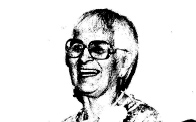Agnes
Semmler

1970
“Indian woman works for
the rights of Eskimos in the N.W.T.”
accompanied by a photo of
Agnes with a subtitle “Spells
out realities.”
(Inuvik, NWT (CP) July, 1970).
“The fireball behind the
burgeoning Northwest Territories
Native Rights Movement is a plumb
middle-aged Indian woman who plots
assaults on federal policies from
the incongruous confines of a
government-operated handicrafts
shop. Agnes Semmler manages the
igloo-shaped shop on the main
street of the mosquito-laden Mackenzie
delta town of 3000 persons north
of the Arctic Circle. The shop
retails some of the finest Eskimo
and Indian art and furs in the
world. Mrs. Semmler is also president
of the Committee of Original Peoples’
Entitlement, a 500 member coalition
of Eskimos, Indians and Métis
formed this spring to force changes
in Ottawa’s northern development
policies.
About 22,000 of the 33,000 people
living in the 1, 300,000 square
miles of the Northwest Territories
are of pure native extraction
or mixed blood, with the 11,000
Eskimos forming the largest single
ethnic unit. Mrs Semmler is a
rare blend of hard-headed businesswoman
and reformer. She has profited
well from the status quo and yet
she is the leader of the first
civil rights organization in territorial
history.
“I was born an Indian in
the Yukon, but I’ve spent
most of my life living among Eskimos
in the Northwest Territories,”
she said in an interview. “I
think I’m more Eskimo than
Indian now.”
Mrs Semmler spelled out a few
of the realities of being a stone-age
Eskimo in 20th century Canada.
“The natives who have moved
to Inuvik and the other towns
have forgotten how to live off
the land.” she said. “Now
they’re all more or less
on welfare: they’ve lost
their boats, their hunting equipment
and their traps.”
The Eskimos have traded living
off the land for welfare cheques,
the freedom of roaming the tundra
for better education and improved
health standards. Unemployment
is the rule rather than the exception.”
The problem is that the overwhelming
majority of adults have little
or no education at all and adult
education efforts at the best
are sporadic.
Mrs Semmler says that because
of the educational gap, the Eskimos
by and large are getting little
or nothing out of the current
oil exploration boom in the Arctic.
The companies, many of them operating
out of Inuvik, are spending $50
million this year.
She said she is deeply concerned
that by the time educated Eskimo
children come out of the schools,
the oil boom will be over and
there won’t be anything to
take its place.
The key to the problem as Mrs.
Semmler and the committee [COPE]
see it is for the federal government
to recognize aboriginal rights
to the land and the resources
it contains.
The Eskimos, unlike the Indians
to the south, signed no treaties
with the Crown and never formally
surrendered title to anything.
Technically, they have no rights
to anything under Ottawa’s
current definition.
Both the [Cope] committee and
the Northwest Territories Indian
Brotherhood cite the United States
government’s pending billion
dollar settlement with the 55,000
natives of Alaska as a precedent
for similar action by the Canadian
Government.
Mrs. Semmler said such a settlement
with northern natives would give
them a cushion of land and cash
to fall back on should the oil
boom go bust. She wants’
a percentage of oil and mineral
revenues allotted directly to
the natives, under native control.
Ottawa has so far flatly refused
to negotiate on aboriginal rights.
Revenues accruing through mining
and oil go directly to federal
coffers in Ottawa.
Mrs. Semmler feels that at least
part of the solution to native
problems lies in direct political
action…At the moment; there
are only two natives – an
Indian and an Eskimo – on
the [NWT Territorial] council,
though Eskimos and Indians form
a clear democratic majority.
“The native people are slowly
becoming aware of this fact and
it is a matter of increasing significance
for them,” she said. “We
may run some candidates and endorse
others.”
“In any event, the [NWT]
government and the white community
are going to have to start paying
a lot more attention to the native
majority from a political standpoint.”
Banks Island – a test
case for Eskimo Survival (by
Boyce Richardson).
(November 26, 1970. The Montreal
Star, p.21)
Western Arctic Eskimo Group
Disputes Ottawa’s Yukon Policy
– Political Movement
Challenges Whites’ Dominant
Role in Development and Presses
for Share in Wealth.
By Edward Cowan (The New York
Times, Saturday, December 26,
1970)
|